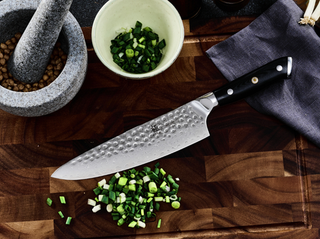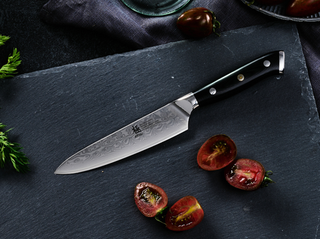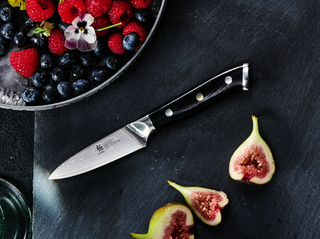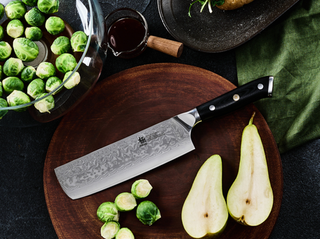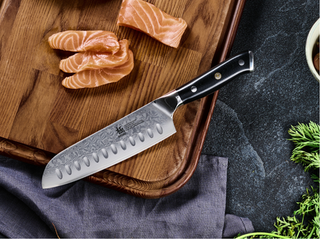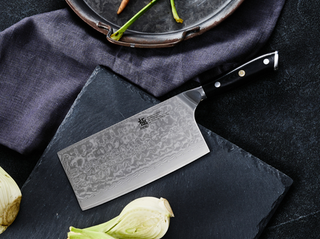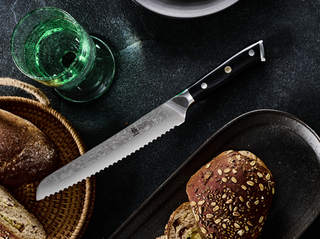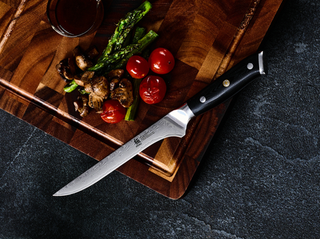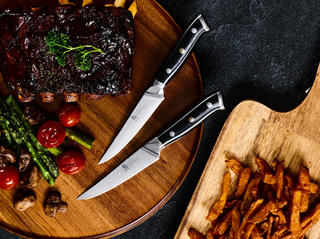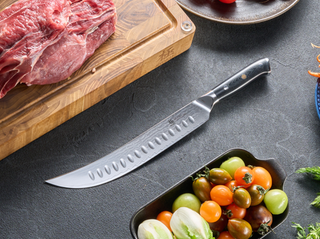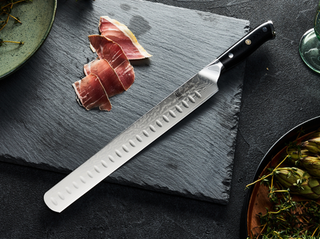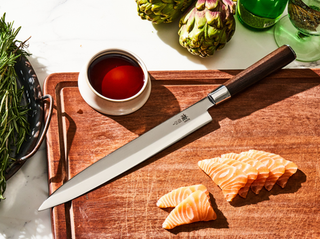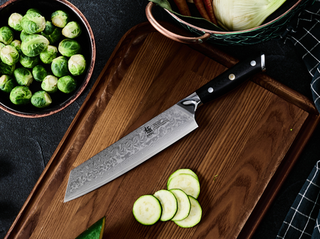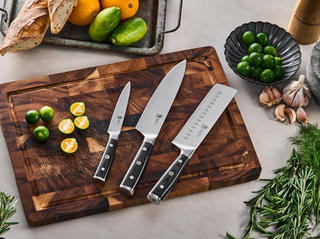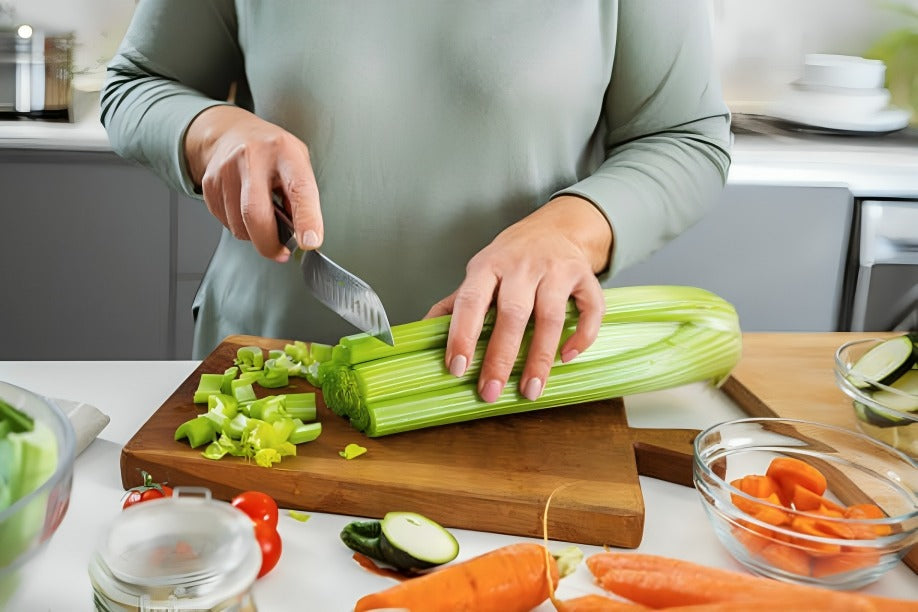One of the best things about celery is just how versatile it is. There are ways you can cut a bunch of celery, and the way you cut it changes how it looks, cooks, and tastes in your dishes.
So, if you’ve ever found yourself staring at a bunch of celery, wondering, “Do I slice it, dice it, or just chop it into sticks?” this is the guide you need.
We will break down the three main ways to cut celery, explain when to use each, and even cover the often-overlooked celery ribs and celery root (celeriac). We've got everything to need to know about cutting celery.

Part 1: Three Ways of Cutting Celery
There are three main ways to cut celery: cutting it into sticks, cutting it into slices, and dicing it into finely chopped pieces. The method you choose depends on how you plan to use the celery:
- Cutting celery into sticks is perfect for snacking, veggie trays, or garnishes like a Bloody Mary
- Cutting celery into slices is ideal for soups, salads, stir-fries, or casseroles.
- Diced celery is perfect for stuffings, sauces, soups, and stews where you want small, even pieces.
Keep in mind that each of these three methods affects texture, cooking time, and presentation, so it’s worth learning the details.
Part 2: How to Cut Celery (Sicks, Slices, or Finely Chopped Pieces)
The process of cutting celery is largely the same, whether you are cutting it into sticks, slicing, or dicing it. First, you wash the celery, place it on the cutting board, ensure a safe and firm grip, and proceed to cut.
The key differences between cutting celery into sticks, slices, and finely chopped pieces lie in how the celery is positioned on the cutting board, how you hold the knife, and the proportions into which it is sliced.
How to Cut Celery into Sticks
- Wash and trim the celery stalks: Wash each stalk thoroughly, removing the base and leafy tops as you go.
- Place the stalk flat on a cutting board. Ensure the curved side is down so it is stable.
- Grip the stalks safely with your non-dominant hand to hold them in place. Remember to use a claw grip so your fingers are protected.
- Cut straight down with a sharp chef’s knife. Since you are cutting into sticks, ensure that they are approximately 2–4 inches long.
- If you're cutting sticks for a veggie tray, halve the thicker stalks lengthwise to get slimmer sticks that look neat and even.
Tip for cutting celery into sticks: Try as much as possible to make the sticks look even. Even celery sticks make your platter look professional and ensure each piece is easy to grab.
How to Slice Celery
The process of slicing celery is much similar to cutting celery into sticks, except that you are cutting crosswise, and into much smaller pieces. Follow these steps:
- Start by washing and trimming as usual.
- Lay the celery stalk(s) flat on the cutting board, curved side down.
- Claw grip with your non-dominant hand for safety.
- Grab a sharp chef’s knife or a utility knife and slice the crosswise into thin pieces, about ⅛–¼ inch thick.
- If you want your sliced celery to look really good and have the maximum decorative appeal, cut them diagonally. This is known as a bias cut in cooking, and it helps expose more of the celery’s ridged surface.
Pro Tip: Celery cut into thin slices cooks evenly and softens just enough for soups or stir-fries while keeping a slight crunch. It is just incredible!
How To Dice Celery
The process of dicing celery demands more precision than cutting into strips or even slicing it into pieces. The stalks have to be cut first into smaller pieces before being diced. Follow these steps to dice your celery:
- As always, start by washing and trimming the stalks.
- Then, cut the stalks into 3–4 inch sections. This makes them easier to handle.
- Slice (the already cut stalks) lengthwise into strips. Each should be about ¼ inch wide.
- Align the strips neatly, then cut crosswise into cubes about ¼ inch or smaller.
Tip: Diced celery works best when uniform in size to ensure even cooking and a balanced texture in sauces, stuffings, or soups.
Part 3: Celery Sticks vs Celery Slices vs Diced Celery: Key Differences
| Cut Type | How It’s Placed | Size / Proportions | Texture | Knife Needed | Uses |
| Sticks | Lay flat, curved side down | 2–4 inches long; half-thick stalks | Crisp and crunchy | Chef’s knife or utility knife | Veggie trays, snacks, Bloody Mary garnish |
| Slices | Lay flat, curved side down | Thin crosswise cuts, ⅛–¼ inch | Tender-crisp cooked; lightly crunchy raw | Chef’s knife or paring knife | Soups, salads, stir-fries |
| Diced | Cut into sections, slice lengthwise, then cross-cut | Small cubes, ¼ inch or smaller | Soft when cooked; fine crunch if raw | Chef’s knife | Stuffings, sauces, soups, stews |
Knowing these differences helps you choose the right cut depending on whether the celery will be eaten raw, cooked, or used for garnish.

Part 4: Dealing With Celery Root (Celeriac)
A lot of people mistake celery root for being the same as celery, but celery root is a different animal entirely, especially when it comes to cutting and using it in dishes.
Celery root (also called celeriac) is the knobby, underground root of the celery plant. Its flavor is similar to celery, but more earthy and nutty.
Also, unlike celery, you peel and cook celery root before eating. Some people do eat it raw, but only when it is finely shredded or diced. It is mostly used for soups, stews, mashes, roasts, and slaws.
How to Cut Celery Root
- Wash thoroughly to remove dirt.
- Peel off the rough skin with a knife or vegetable peeler.
- Trim the top and root tip.
- Cut into rounds, sticks, or cubes, depending on the recipe.
- You may also want to submerge cut pieces in water with a little lemon juice to prevent browning.
- Celery root is hearty and needs proper prep, but it adds rich flavor and texture to any dish.
Part 5: Using Celery Ribs
If a recipe calls for a celery rib, don’t overthink it. A rib is simply one individual stalk from a bunch of celery. The process of cutting celery root is precisely the same as cutting celery, except that you need to separate the celery stalks from the bunch first.
- The ribs are the long, curved stalks attached to the base of the celery head.
- You can pull them off by hand or cut them free at the base.
- After separating the rib, you can cut it into sticks, slices, or dice, depending on your recipe.
Think of ribs as the “building blocks” of the celery bunch. Understanding this term makes following recipes much easier.
Part 6: Celery Ribs vs. Celery Roots
| Feature | Celery Ribs (Stalks) | Celery Root (Celeriac) |
| Part of Plant | Above-ground stalks | Underground root |
| Appearance | Long, green, curved | Knobby, round, brownish |
| Texture | Crisp raw; tender-crisp cooked | Dense and firm; tender when cooked |
| Flavor | Mild, slightly sweet | Earthy, nutty, celery-like |
| Preparation | Wash, trim, cut into sticks, slices, or dice | Wash, peel, trim, cut into rounds, sticks, or dice |
| Typical Uses | Salads, soups, stews, veggie trays, garnishes | Soups, stews, mashes, roasts, slaws |
| Special Tips | Best raw or lightly cooked; keep cuts even | Prevent browning with water and lemon; cook thoroughly for best texture |
Best Knives for Cutting Celery
1. Chef Knives
A chef's knife is the perfect choice for cutting celery. Look for a chef’s knife with a longer blade ( preferably 8 inches) and a gentle curve along the edge so you can use smooth rocking motions. You also want a chef’s knife with a thin, sharp edge for clean cuts.
Consider the 8" Gyuto Chef Knife from Kyoku’s collection. The 8-inch blade is made of VG10 Damascus Steel and has a deep, smooth curve.
As part of Kyoku’s Shogun series, the blade is ruthlessly a mirror polish at 8-12° double-sided, and it is cryogenically treated for incredible hardness, flexibility, and corrosion resistance.
For more options, you can explore more 8-inch chef knife reviews
2. Utility Knives
Utility knives are also fairly good for cutting celery, especially if you are not dealing with a large volume. A utility knife is sharp, maneuverable, and ideal for slicing individual stalks or small portions.
Consider this 6-inch Utility Knife. Also from Kyoku’s Shogun series, it features a 6-inch blade made of VG10 Damascus Steel. It is one of the most versatile kitchen knives you can have, and with a gorgeous, hammer-beaten herringbone pattern, it is well-equipped to prevent food from sticking to the blade as well.

Conclusion
Cutting celery may seem simple, but understanding sticks, slices, dice, ribs, and roots can elevate your cooking. Choosing the right cut improves texture, presentation, and even cooking time. Next time you reach for celery, you’ll know exactly how to handle it, whether it’s a crunchy rib for a snack, tender slices for soup, or earthy celeriac for a hearty stew.
